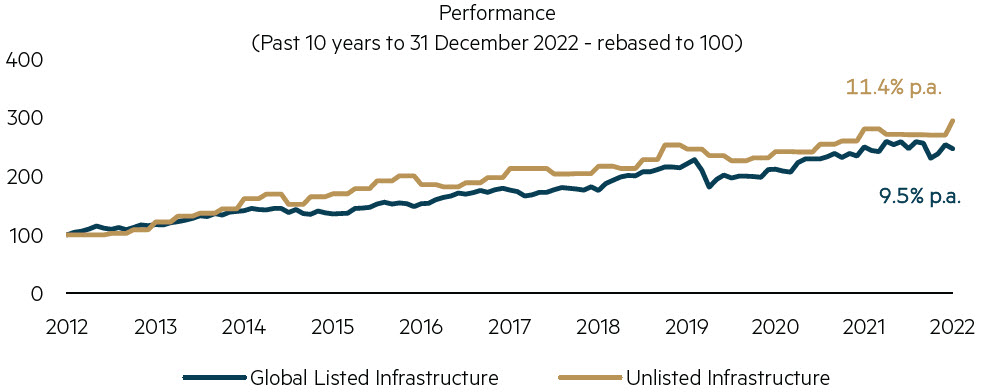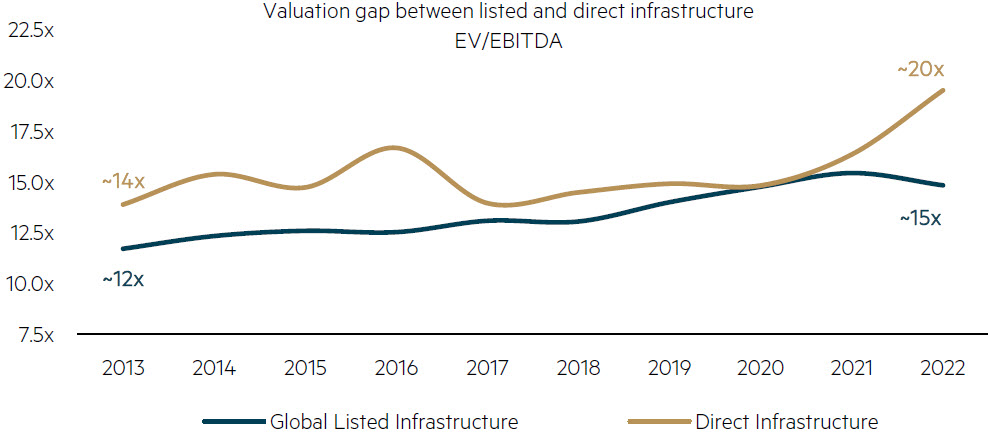Is the tide turning for listed infrastructure returns?
In general, infrastructure assets have performed well over the past decade. For the 10 years to 31 December 2022, the listed infrastructure sector delivered 9.5% p.a. while the unlisted infrastructure sector delivered 11.4% p.a. (see Figure 1). We are commonly asked to what extent these return differentials should be viewed as ongoing differences between the listed and unlisted markets versus those caused by temporary factors.
Figure 1: Performance of listed versus unlisted infrastructure

Notes: Global Listed Infrastructure is represented by the FTSE Global Core Infrastructure 50/50 100% Hedged to USD (Gross) Index. Unlisted Infrastructure is represented by the EDHEC infra300 Equity Index (Local).
In considering performance over the past 10 years, we believe these two factors were key reasons behind the higher returns seen by unlisted infrastructure. The higher leverage in the unlisted markets was positive during a period when asset values were rising. Additionally, the widening valuation gap between the listed and direct markets has driven an even stronger performance outcome for unlisted infrastructure.
Figure 2: Listed versus direct infrastructure valuations over the past decade

Notes: Global Listed Infrastructure is represented by the grossed-up weighted average EV/EBITDA of FTSE Global Core Infrastructure 50/50 Index constituents. Data uses broker consensus estimates and has been sourced from Bloomberg. It is substantially complete, although is missing a few data points due to either stocks not yet being listed or there being insufficient consensus estimates at any point in time. We have reviewed the data and are confident the results are not being distorted by any extreme individual data points. Unlisted Infrastructure is represented by the average EV/EBITDA of infrastructure transactions occurring within a given year. Analysis is based on approximately 240 infrastructure transactions occurring between 2013 and 2022. Past performance is not a reliable indicator of future performance.
Our views on this are:
(2) For unlisted infrastructure to overcome this headwind and produce equivalent or better performance than listed – when investing in effectively the same assets – they will be dependent on one or both of:
(b) the gap between listed and direct infrastructure valuations continuing to widen.
If either of these assumptions begins to reverse, then we would expect unlisted infrastructure returns to face greater performance headwinds relative to listed.
This wire was co-authored with Kevin Zeng, Investment Analyst, Global Listed Infrastructure, Maple-Brown Abbott. To read our full note on this topic please refer to the attached PDF.

4 topics
Andrew Maple-Brown started Maple-Brown Abbott Global Listed Infrastructure with three partners in 2012, holding the belief that the best way to align with investors was through a boutique ownership structure. With more than 20 years’ experience in...
Expertise
Andrew Maple-Brown started Maple-Brown Abbott Global Listed Infrastructure with three partners in 2012, holding the belief that the best way to align with investors was through a boutique ownership structure. With more than 20 years’ experience in...
.jpg)
.jpg)